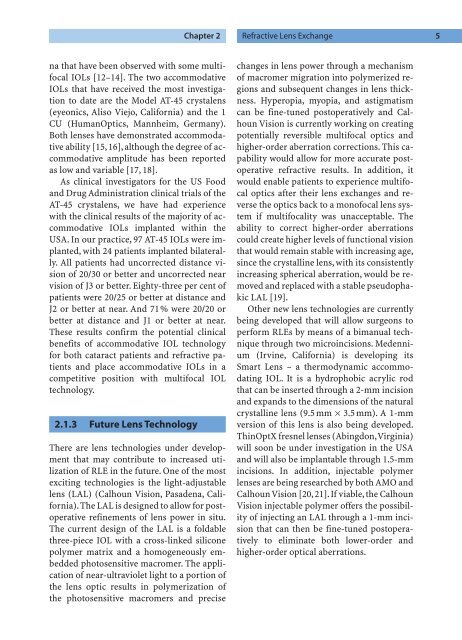Refractive Lens Surgery
Refractive Lens Surgery
Refractive Lens Surgery
You also want an ePaper? Increase the reach of your titles
YUMPU automatically turns print PDFs into web optimized ePapers that Google loves.
na that have been observed with some multifocal<br />
IOLs [12–14]. The two accommodative<br />
IOLs that have received the most investigation<br />
to date are the Model AT-45 crystalens<br />
(eyeonics, Aliso Viejo, California) and the 1<br />
CU (HumanOptics, Mannheim, Germany).<br />
Both lenses have demonstrated accommodative<br />
ability [15, 16], although the degree of accommodative<br />
amplitude has been reported<br />
as low and variable [17, 18].<br />
As clinical investigators for the US Food<br />
and Drug Administration clinical trials of the<br />
AT-45 crystalens, we have had experience<br />
with the clinical results of the majority of accommodative<br />
IOLs implanted within the<br />
USA. In our practice, 97 AT-45 IOLs were implanted,<br />
with 24 patients implanted bilaterally.<br />
All patients had uncorrected distance vision<br />
of 20/30 or better and uncorrected near<br />
vision of J3 or better. Eighty-three per cent of<br />
patients were 20/25 or better at distance and<br />
J2 or better at near. And 71% were 20/20 or<br />
better at distance and J1 or better at near.<br />
These results confirm the potential clinical<br />
benefits of accommodative IOL technology<br />
for both cataract patients and refractive patients<br />
and place accommodative IOLs in a<br />
competitive position with multifocal IOL<br />
technology.<br />
2.1.3 Future <strong>Lens</strong> Technology<br />
There are lens technologies under development<br />
that may contribute to increased utilization<br />
of RLE in the future. One of the most<br />
exciting technologies is the light-adjustable<br />
lens (LAL) (Calhoun Vision, Pasadena, California).The<br />
LAL is designed to allow for postoperative<br />
refinements of lens power in situ.<br />
The current design of the LAL is a foldable<br />
three-piece IOL with a cross-linked silicone<br />
polymer matrix and a homogeneously embedded<br />
photosensitive macromer. The application<br />
of near-ultraviolet light to a portion of<br />
the lens optic results in polymerization of<br />
the photosensitive macromers and precise<br />
Chapter 2 <strong>Refractive</strong> <strong>Lens</strong> Exchange 5<br />
changes in lens power through a mechanism<br />
of macromer migration into polymerized regions<br />
and subsequent changes in lens thickness.<br />
Hyperopia, myopia, and astigmatism<br />
can be fine-tuned postoperatively and Calhoun<br />
Vision is currently working on creating<br />
potentially reversible multifocal optics and<br />
higher-order aberration corrections. This capability<br />
would allow for more accurate postoperative<br />
refractive results. In addition, it<br />
would enable patients to experience multifocal<br />
optics after their lens exchanges and reverse<br />
the optics back to a monofocal lens system<br />
if multifocality was unacceptable. The<br />
ability to correct higher-order aberrations<br />
could create higher levels of functional vision<br />
that would remain stable with increasing age,<br />
since the crystalline lens, with its consistently<br />
increasing spherical aberration, would be removed<br />
and replaced with a stable pseudophakic<br />
LAL [19].<br />
Other new lens technologies are currently<br />
being developed that will allow surgeons to<br />
perform RLEs by means of a bimanual technique<br />
through two microincisions. Medennium<br />
(Irvine, California) is developing its<br />
Smart <strong>Lens</strong> – a thermodynamic accommodating<br />
IOL. It is a hydrophobic acrylic rod<br />
that can be inserted through a 2-mm incision<br />
and expands to the dimensions of the natural<br />
crystalline lens (9.5 mm × 3.5 mm). A 1-mm<br />
version of this lens is also being developed.<br />
ThinOptX fresnel lenses (Abingdon,Virginia)<br />
will soon be under investigation in the USA<br />
and will also be implantable through 1.5-mm<br />
incisions. In addition, injectable polymer<br />
lenses are being researched by both AMO and<br />
Calhoun Vision [20, 21]. If viable, the Calhoun<br />
Vision injectable polymer offers the possibility<br />
of injecting an LAL through a 1-mm incision<br />
that can then be fine-tuned postoperatively<br />
to eliminate both lower-order and<br />
higher-order optical aberrations.



